Seasonal Variation of Submesoscale Ageostrophic Motion and Geostrophic Energy Cascade in the Kuroshio
Abstract
:1. Introduction
2. Materials and Methods
2.1. Study Area
2.2. Data and Methods
2.2.1. Velocity Data
2.2.2. Mixed Layer Depth Data
2.2.3. Calculation of Geostrophic and Ageostrophic Energy
2.2.4. Geostrophic Strain
2.2.5. Kinetic Energy Spectral Density
2.2.6. Kinetic Energy Transfer Rate
3. Results and Discussion
3.1. Analysis of Seasonal Variation of Ocean Submesoscale Ageostrophic Motion
3.2. Relationship between Ageostrophic Submesoscale Motions, Geostrophic Strain, and Mixed Layer Depth
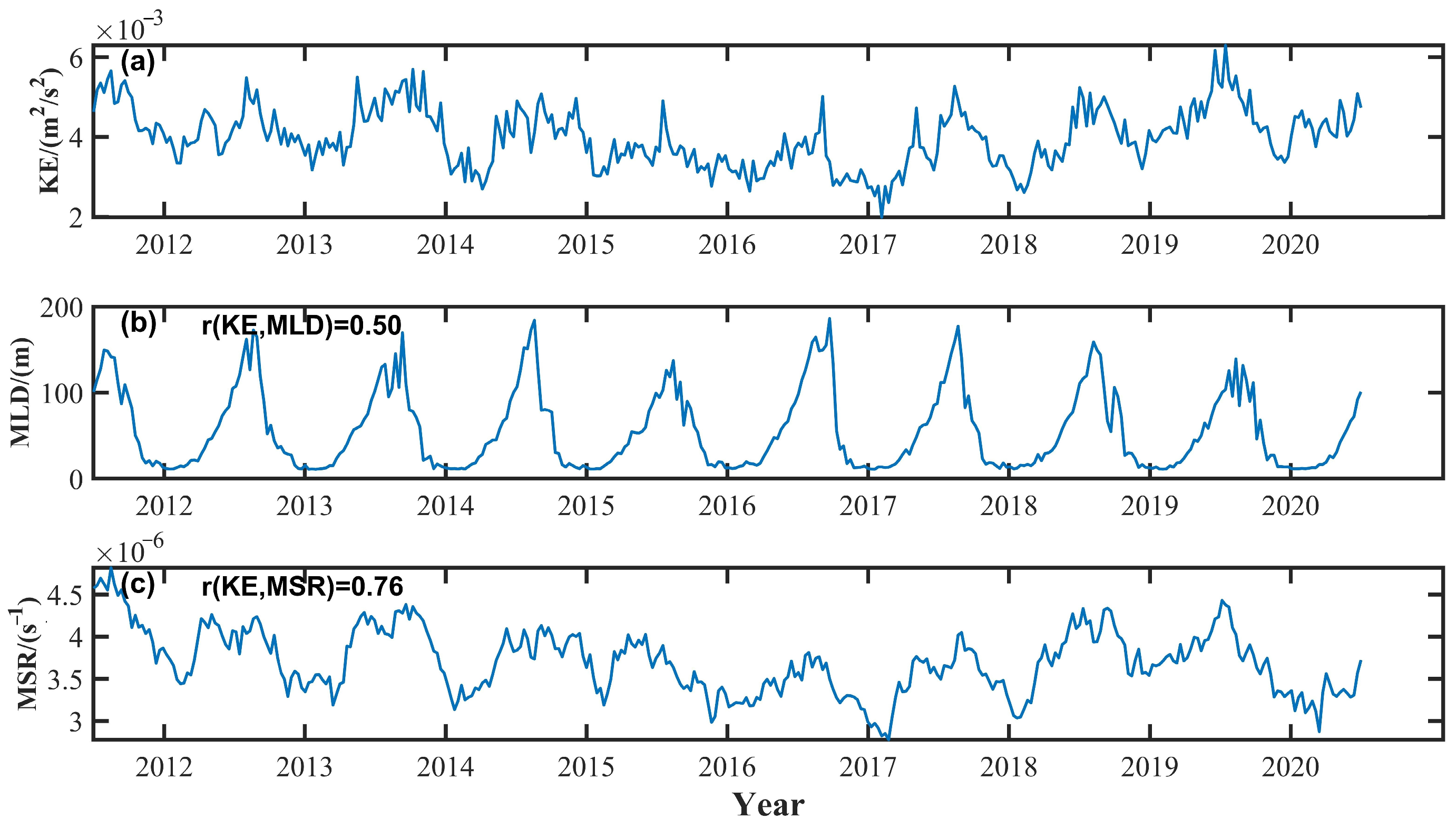
3.3. Vertical Changes in Submesoscale KE under Different Conditions
3.4. Distribution of Kinetic Energy Spectrum in the Kuroshio
3.5. Distribution of Kinetic Energy Transfer Rate in the Kuroshio
4. Conclusions
Author Contributions
Funding
Institutional Review Board Statement
Informed Consent Statement
Data Availability Statement
Conflicts of Interest
References
- Chunhua, Q.; Zihao, Y.; Dongxiao, W.; Ming, F.; Jingzhi, S. The Enhancement of Submesoscale Ageostrophic Motion on the Mesoscale Eddies in the South China Sea. J. Geophys. Res. Ocean. 2022, 127, e2022JC018736. [Google Scholar] [CrossRef]
- McWilliams, J.C. Submesoscale surface fronts and filaments: Secondary circulation, buoyancy flux, and frontogenesis. J. Fluid Mech. 2017, 823, 391–432. [Google Scholar] [CrossRef]
- D’asaro, E.; Lee, C.; Rainville, L.; Harcourt, R.; Thomas, L. Enhanced turbulence and energy dissipation at ocean fronts. Science 2011, 332, 318–322. [Google Scholar] [CrossRef] [PubMed]
- Flagg, C.N.; Dunn, M.; Wang, D.P.; Rossby, H.T.; Benway, R.L. A study of the currents of the outer shelf and upper slope from a decade of shipboard ADCP observations in the Middle Atlantic Bight. J. Geophys. Res. Ocean. 2006, 111. [Google Scholar] [CrossRef]
- Nagai, T.; Tandon, A.; Rudnick, D.L. Two-dimensional ageostrophic secondary circulation at ocean fronts due to vertical mixing and large-scale deformation. J. Geophys. Res. Ocean. 2006, 111. [Google Scholar] [CrossRef]
- Zhang, Z.; Qiu, B.; Klein, P.; Travis, S. The influence of geostrophic strain on oceanic ageostrophic motion and surface chlorophyll. Nat. Commun. 2019, 10, 2838. [Google Scholar] [CrossRef] [PubMed]
- Qiu, B.; Kelly, K.A.; Joyce, T.M. Mean flow and variability in the Kuroshio Extension from Geosat altimetry data. J. Geophys. Res. Ocean. 1991, 96, 18491–18507. [Google Scholar] [CrossRef]
- Cao, H.; Fox-Kemper, B.; Jing, Z. Submesoscale eddies in the upper ocean of the Kuroshio Extension from high-resolution simulation: Energy budget. J. Phys. Oceanogr. 2021, 51, 2181–2201. [Google Scholar] [CrossRef]
- Morrow, R.; Fu, L.-L. Observing mesoscale to submesoscale dynamics today, and in the future with SWOT. In Proceedings of the 2011 IEEE International Geoscience and Remote Sensing Symposium, Vancouver, BC, Canada, 24–29 July 2011; pp. 2689–2691. [Google Scholar] [CrossRef]
- Nagai, T.; Tandon, A.; Gruber, N.; McWilliams, J.C. Biological and physical impacts of ageostrophic frontal circulations driven by confluent flow and vertical mixing. Dyn. Atmos. Ocean. 2008, 45, 229–251. [Google Scholar] [CrossRef]
- Zhang, Z.; Zhao, W.; Qiu, B.; Tian, J. Anticyclonic eddy sheddings from Kuroshio loop and the accompanying cyclonic eddy in the northeastern South China Sea. J. Phys. Oceanogr. 2017, 47, 1243–1259. [Google Scholar] [CrossRef]
- Hoskins, B.J.; Bretherton, F.P. Atmospheric frontogenesis models: Mathematical formulation and solution. J. Atmos. Sci. 1972, 29, 11–37. [Google Scholar] [CrossRef]
- Qiu, B.; Nakano, T.; Chen, S.; Klein, P. Bi-directional energy cascades in the Pacific Ocean from equator to subarctic gyre. Geophys. Res. Lett. 2022, 49, e2022GL097713. [Google Scholar] [CrossRef]
- Siegelman, L.; Klein, P.; Rivière, P.; Thompson, A.F.; Torres, H.S.; Flexas, M.; Menemenlis, D. Enhanced upward heat transport at deep submesoscale ocean fronts. Nat. Geosci. 2020, 13, 50–55. [Google Scholar] [CrossRef]
- Zhang, Y.; Zhang, S.; Afanasyev, Y.D. Energy cascades in surface semi-geostrophic turbulence. Authorea Prepr. 2024. [Google Scholar] [CrossRef]
- Lin, R.Q.; Chubb, S. Energy cascades in the upper ocean. Chin. J. Oceanol. Limnol. 2006, 24, 225–235. [Google Scholar] [CrossRef]
- Sasaki, H.; Klein, P.; Qiu, B.; Sasai, Y. Impact of oceanic-scale interactions on the seasonal modulation of ocean dynamics by the atmosphere. Nat. Commun. 2014, 5, 5636. [Google Scholar] [CrossRef]
- Bos, W.; Kadoch, B.; Schneider, K.; Bertoglio, J. Inertial range scaling of the scalar flux spectrum in two-dimensional turbulence. Phys. Fluids 2009, 21, 115105:115101–115105:115108. [Google Scholar] [CrossRef]
- Colas, F.; Capet, X.; McWilliams, J.C.; Li, Z. Mesoscale eddy buoyancy flux and eddy-induced circulation in Eastern Boundary Currents. J. Phys. Oceanogr. 2013, 43, 1073–1095. [Google Scholar] [CrossRef]
- Li, S.; Zhong, Y.; Zhou, M.; Wu, H.; Gao, Y.; Zhou, P.; Wang, Y.; Zhang, Z.; Zhang, H. The Summer Kuroshio Intrusion Into the East China Sea Revealed by a New Mixed-Layer Water Mass Analysis. J. Geophys. Res. Ocean. 2024, 129, e2023JC020827. [Google Scholar] [CrossRef]
- Jiang, Y.X.; Sun, J.X.; Wu, X.H.; Wang, H. Impacts of the Kuroshio Extension Stability on the Storm-track over the North Pacific. J. Phys. Conf. Ser. 2024, 2718, 012039. [Google Scholar] [CrossRef]
- Qiu, B.; Scott, R.B.; Chen, S. Length scales of eddy generation and nonlinear evolution of the seasonally modulated South Pacific Subtropical Countercurrent. J. Phys. Oceanogr. 2008, 38, 1515–1528. [Google Scholar] [CrossRef]
- Zhang, Z.; Qiu, B. Evolution of submesoscale ageostrophic motions through the life cycle of oceanic mesoscale eddies. Geophys. Res. Lett. 2018, 45, 11847–11855. [Google Scholar] [CrossRef]
- Kuo, Y.-C.; Tseng, Y.-H. Influence of anomalous low-level circulation on the Kuroshio in the Luzon Strait during ENSO. Ocean Model. 2021, 159, 101759. [Google Scholar] [CrossRef]
- Yang, P.; Jing, Z.; Sun, B.; Wu, L.; Qiu, B.; Chang, P.; Ramachandran, S.; Yuan, C. On the Upper-Ocean Vertical Eddy Heat Transport in the Kuroshio Extension. Part II: Effects of Air–Sea Interactions. J. Phys. Oceanogr. 2021, 51, 3297–3312. [Google Scholar] [CrossRef]
- Motomura, H.; Matsunuma, M. Fish diversity along the Kuroshio Current. In Fish Diversity of Japan: Evolution, Zoogeography, and Conservation; Springer: Berlin/Heidelberg, Germany, 2022; pp. 63–78. [Google Scholar] [CrossRef]
- Tozuka, T.; Sasai, Y.; Yasunaka, S.; Sasaki, H.; Nonaka, M. Simulated decadal variations of surface and subsurface phytoplankton in the upstream Kuroshio Extension region. Prog. Earth Planet. Sci. 2022, 9, 70. [Google Scholar] [CrossRef]
- Masaaki, S.; Yohei, N.; Masakazu, H. Potential stocks of reef fish-based ecosystem services in the Kuroshio Current region: Their relationship with latitude and biodiversity. Popul. Ecol. 2020, 63, 75–91. [Google Scholar] [CrossRef]
- Shuyang, M.; Yongjun, T.; Jianchao, L.; Peilong, J.; Peng, S.; Zhenjiang, Y.; Yang, L.; Yoshiro, W. Incorporating thermal niche to benefit understanding climate-induced biological variability in small pelagic fishes in the Kuroshio ecosystem. Fish. Oceanogr. 2022, 31, 172–190. [Google Scholar] [CrossRef]
- Li, Q.P.; Wang, Y.; Dong, Y.; Gan, J. Modeling long-term change of planktonic ecosystems in the northern S outh C hina S ea and the upstream K uroshio C urrent. J. Geophys. Res. Ocean 2015, 120, 3913–3936. [Google Scholar] [CrossRef]
- Yatsu, A.; Chiba, S.; Yamanaka, Y.; Ito, S.I.; Shimizu, Y.; Kaeriyama, M.; Watanabe, Y. Climate forcing and the Kuroshio/Oyashio ecosystem. ICES J. Mar. Sci. 2013, 70, 922–933. [Google Scholar] [CrossRef]
- Chiba, S.; Lorenzo, E.D.; Davis, A.; Keister, J.E.; Taguchi, B.; Sasai, Y.; Sugisaki, H. Large-scale climate control of zooplankton transport and biogeography in the Kuroshio-Oyashio Extension region. Geophys. Res. Lett. 2013, 40, 5182–5187. [Google Scholar] [CrossRef]
- Zhang, J.; Li, C.; Luo, X. Response of Sea Surface Heat Flux to the Kuroshio Extension Ocean Front for Different Background Wind Fields. J. Coast. Res. 2020, 99, 332–339. [Google Scholar] [CrossRef]
- Shan, X.; Jing, Z.; Gan, B.; Wu, L.; Chang, P.; Ma, X.; Wang, S.; Chen, Z.; Yang, H. Surface Heat Flux Induced by Mesoscale Eddies Cools the Kuroshio-Oyashio Extension Region. Geophys. Res. Lett. 2020, 47, e2019GL086050. [Google Scholar] [CrossRef]
- Tozuka, T.; Cronin, M.F.; Tomita, H. Surface frontogenesis by surface heat fluxes in the upstream Kuroshio Extension region. Sci. Rep. 2017, 7, 10258. [Google Scholar] [CrossRef]
- Taguchi, B.; Qiu, B.; Nonaka, M.; Sasaki, H.; Xie, S.-P.; Schneider, N. Decadal variability of the Kuroshio Extension: Mesoscale eddies and recirculations. Ocean Dyn. 2010, 60, 673–691. [Google Scholar] [CrossRef]
- Chang, Y.L.K.; Miyazawa, Y.; Miller, M.J.; Tsukamoto, K. Influence of ocean circulation and the Kuroshio large meander on the 2018 Japanese eel recruitment season. PLoS ONE 2019, 14, e0223262. [Google Scholar] [CrossRef] [PubMed]
- Chen, L.; Jia, Y.; Liu, Q. Oceanic eddy-driven atmospheric secondary circulation in the winter Kuroshio Extension region. J. Oceanogr. 2017, 73, 295–307. [Google Scholar] [CrossRef]
- Qiu, B.; Chen, S. Variability of the Kuroshio Extension jet, recirculation gyre, and mesoscale eddies on decadal time scales. J. Phys. Oceanogr. 2005, 35, 2090–2103. [Google Scholar] [CrossRef]
- Joh, Y.; Delworth, T.L.; Wittenberg, A.T.; Cooke, W.F.; Rosati, A.J.; Zhang, L. Stronger decadal variability of the Kuroshio Extension under simulated future climate change. NPJ Clim. Atmos. Sci. 2022, 5, 63. [Google Scholar] [CrossRef]
- Geng, Y.; Ren, H.-L.; Ma, X.; Zhao, S.; Nie, Y. Responses of East Asian Climate to SST Anomalies in the Kuroshio Extension Region during Boreal Autumn. J. Clim. 2022, 35, 7007–7023. [Google Scholar] [CrossRef]
- Ji, J.; Dong, C.; Zhang, B.; Liu, Y.; Zou, B.; King, G.P.; Xu, G.; Chen, D. Oceanic eddy characteristics and generation mechanisms in the Kuroshio Extension region. J. Geophys. Res. Ocean. 2018, 123, 8548–8567. [Google Scholar] [CrossRef]
- Zhang, Z.; Xie, L.; Zheng, Q.; Li, M.; Li, J.; Li, M. Coherence of Eddy Kinetic Energy Variation during Eddy Life Span to Low-Frequency Ageostrophic Energy. Remote Sens. 2022, 14, 3793. [Google Scholar] [CrossRef]
- Zhang, J.; Zhang, Z.; Qiu, B.; Zhang, X.; Sasaki, H.; Zhao, W.; Tian, J. Seasonal modulation of submesoscale kinetic energy in the upper ocean of the northeastern South China Sea. J. Geophys. Res. Ocean. 2021, 126, e2021JC017695. [Google Scholar] [CrossRef]
- Gula, J.; Molemaker, M.J.; McWilliams, J.C. Topographic vorticity generation, submesoscale instability and vortex street formation in the Gulf Stream. Geophys. Res. Lett. 2015, 42, 4054–4062. [Google Scholar] [CrossRef]
- Srinivasan, K.; McWilliams, J.C.; Renault, L.; Hristova, H.G.; Molemaker, J.; Kessler, W.S. Topographic and mixed layer submesoscale currents in the near-surface southwestern tropical Pacific. J. Phys. Oceanogr. 2017, 47, 1221–1242. [Google Scholar] [CrossRef]
- Boccaletti, G.; Ferrari, R.; Fox-Kemper, B. Mixed layer instabilities and restratification. J. Phys. Oceanogr. 2007, 37, 2228–2250. [Google Scholar] [CrossRef]
- Fox-Kemper, B.; Ferrari, R.; Hallberg, R. Parameterization of mixed layer eddies. Part I: Theory and diagnosis. J. Phys. Oceanogr. 2008, 38, 1145–1165. [Google Scholar] [CrossRef]
- Schubert, R.; Vergara, O.; Gula, J. The open ocean kinetic energy cascade is strongest in late winter and spring. Commun. Earth Environ. 2023, 4, 450. [Google Scholar] [CrossRef]
- Evans, D.G.; Frajka-Williams, E.; Naveira Garabato, A.C. Dissipation of mesoscale eddies at a western boundary via a direct energy cascade. Sci. Rep. 2022, 12, 887. [Google Scholar] [CrossRef]
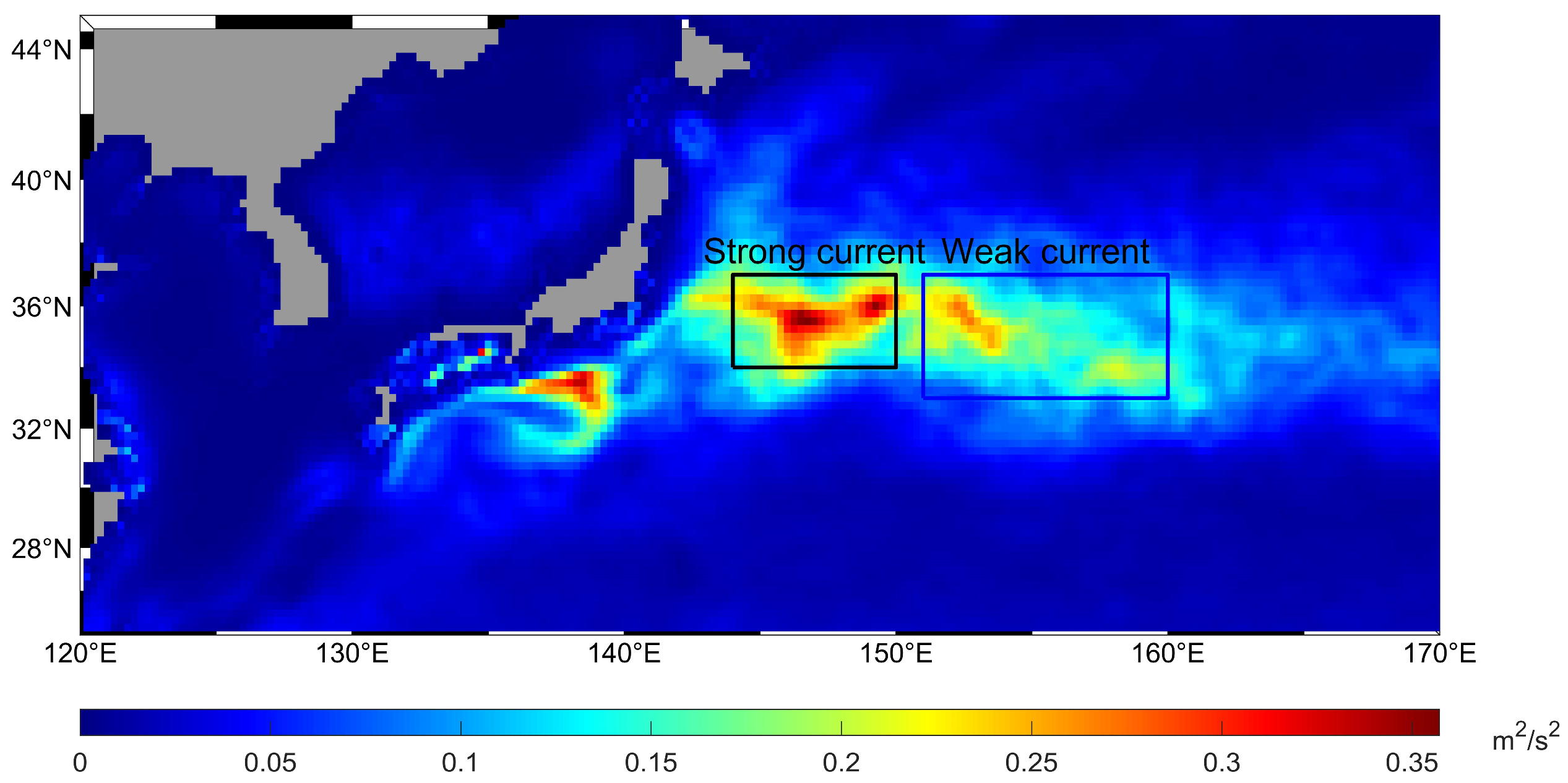
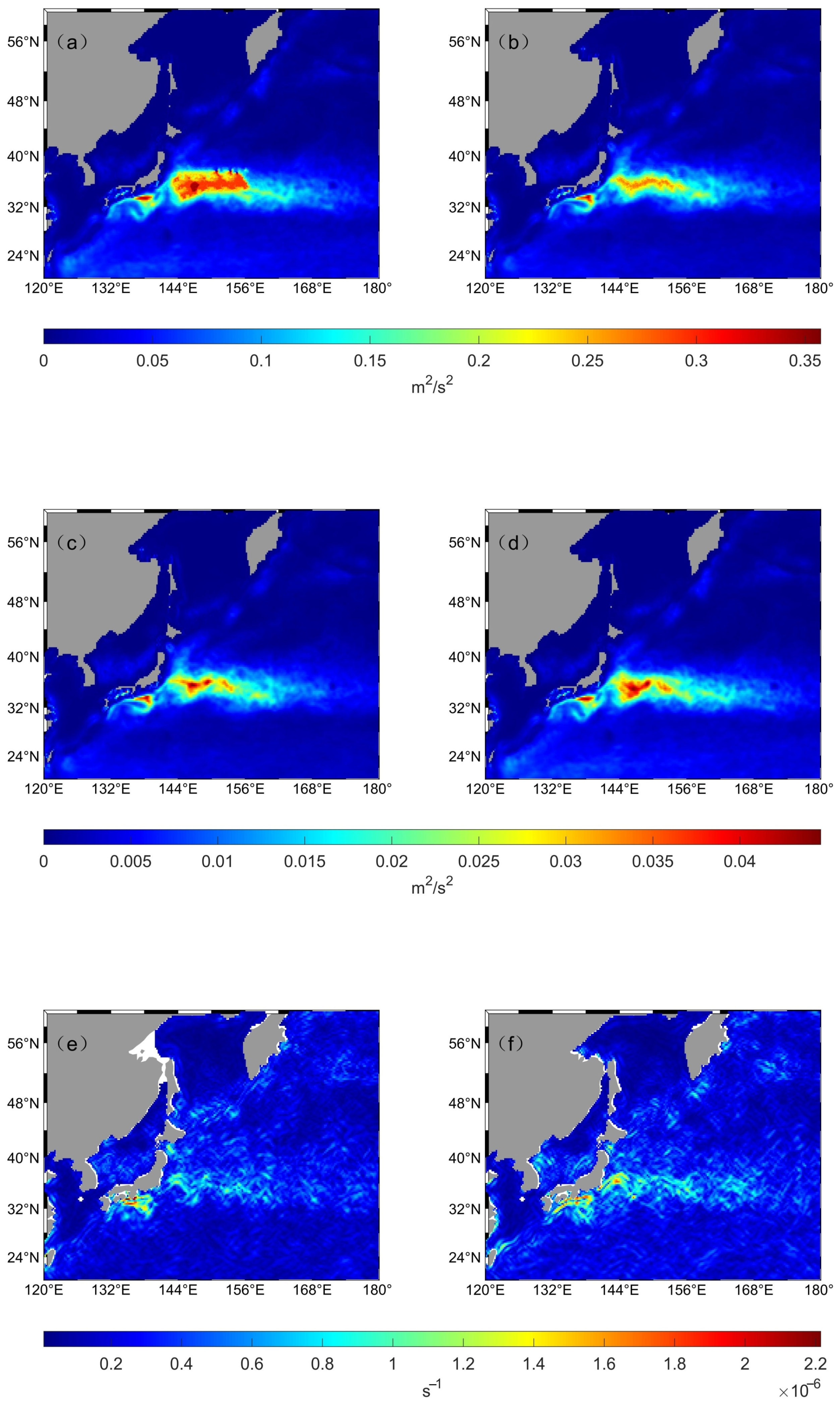
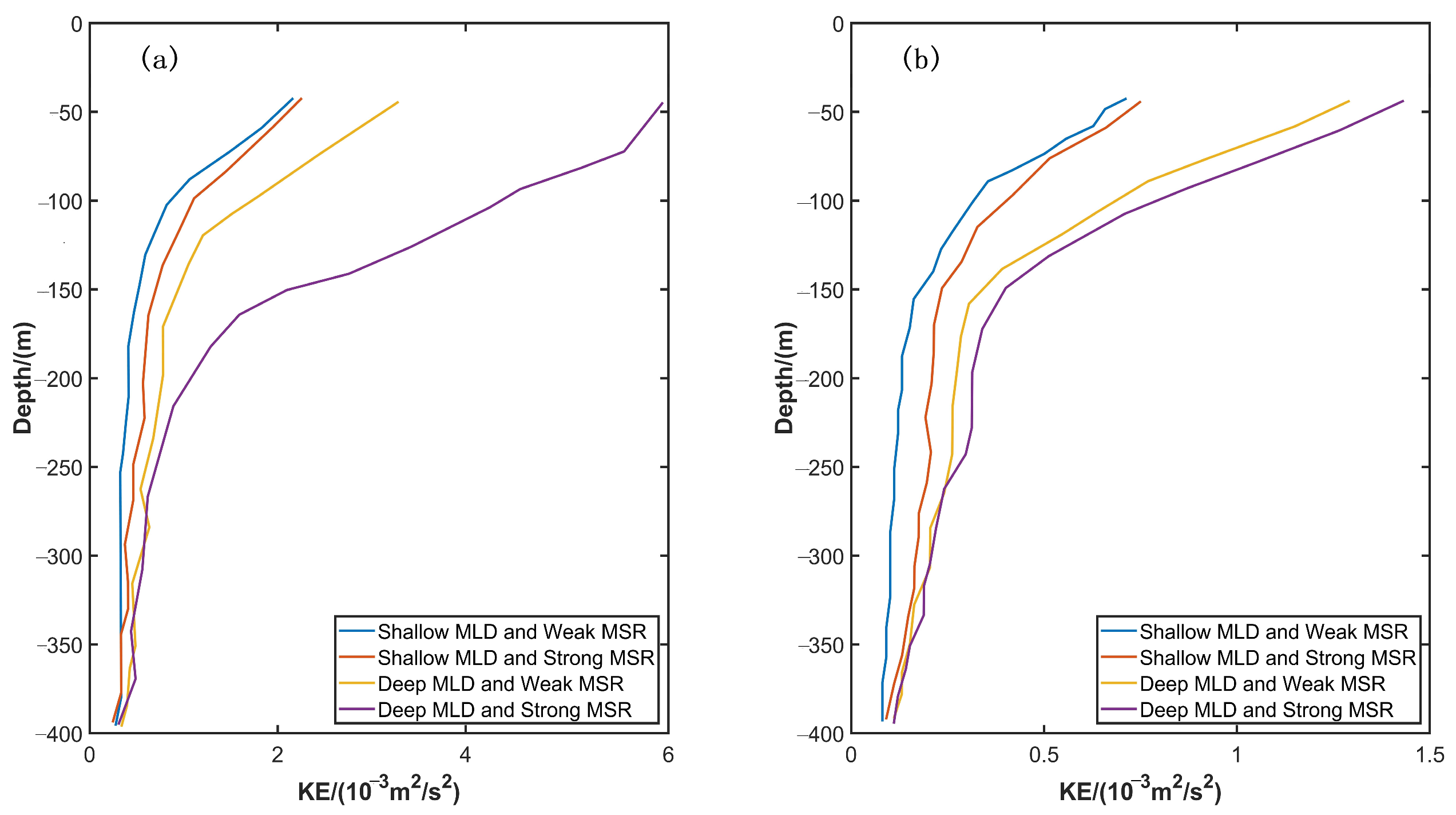

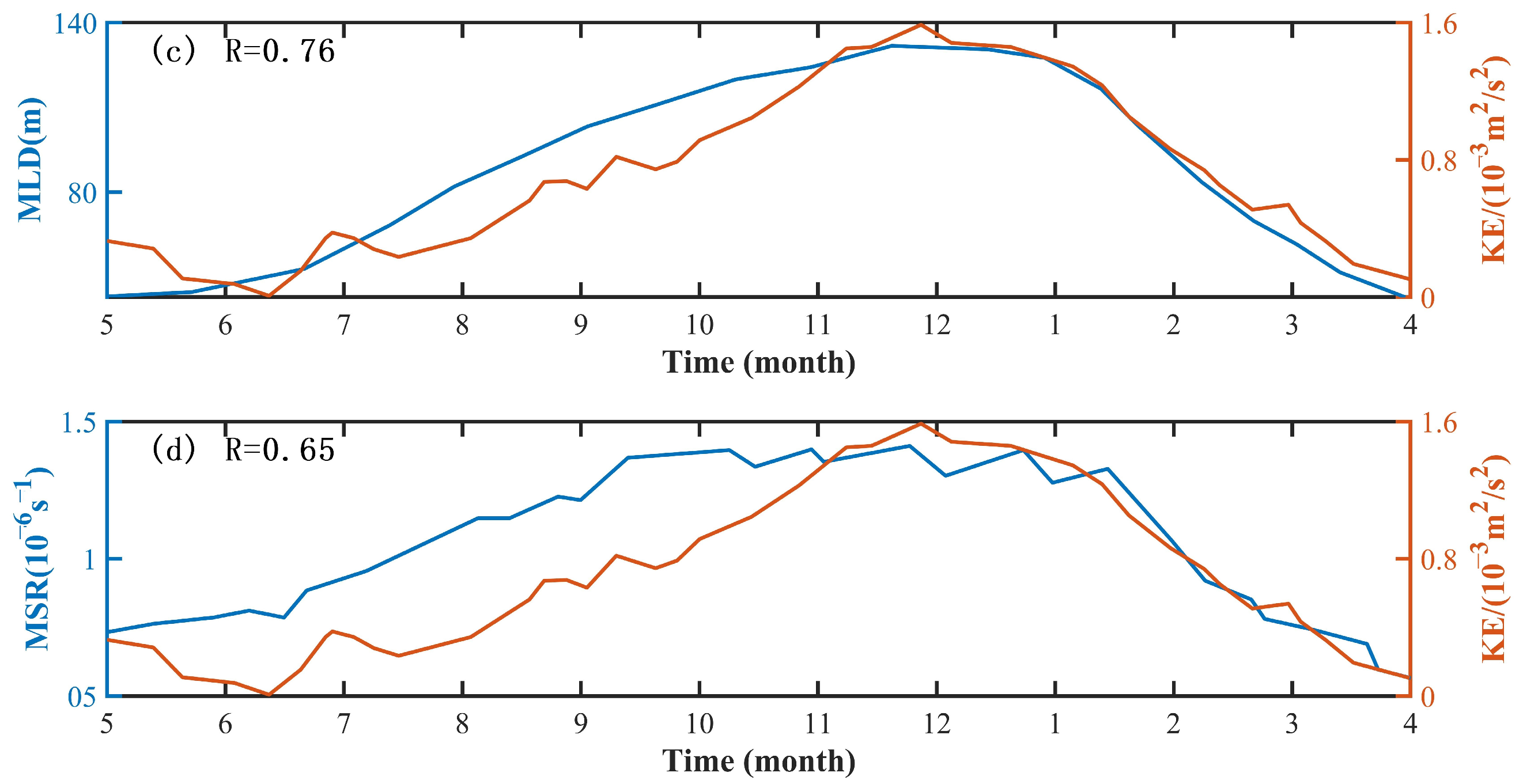

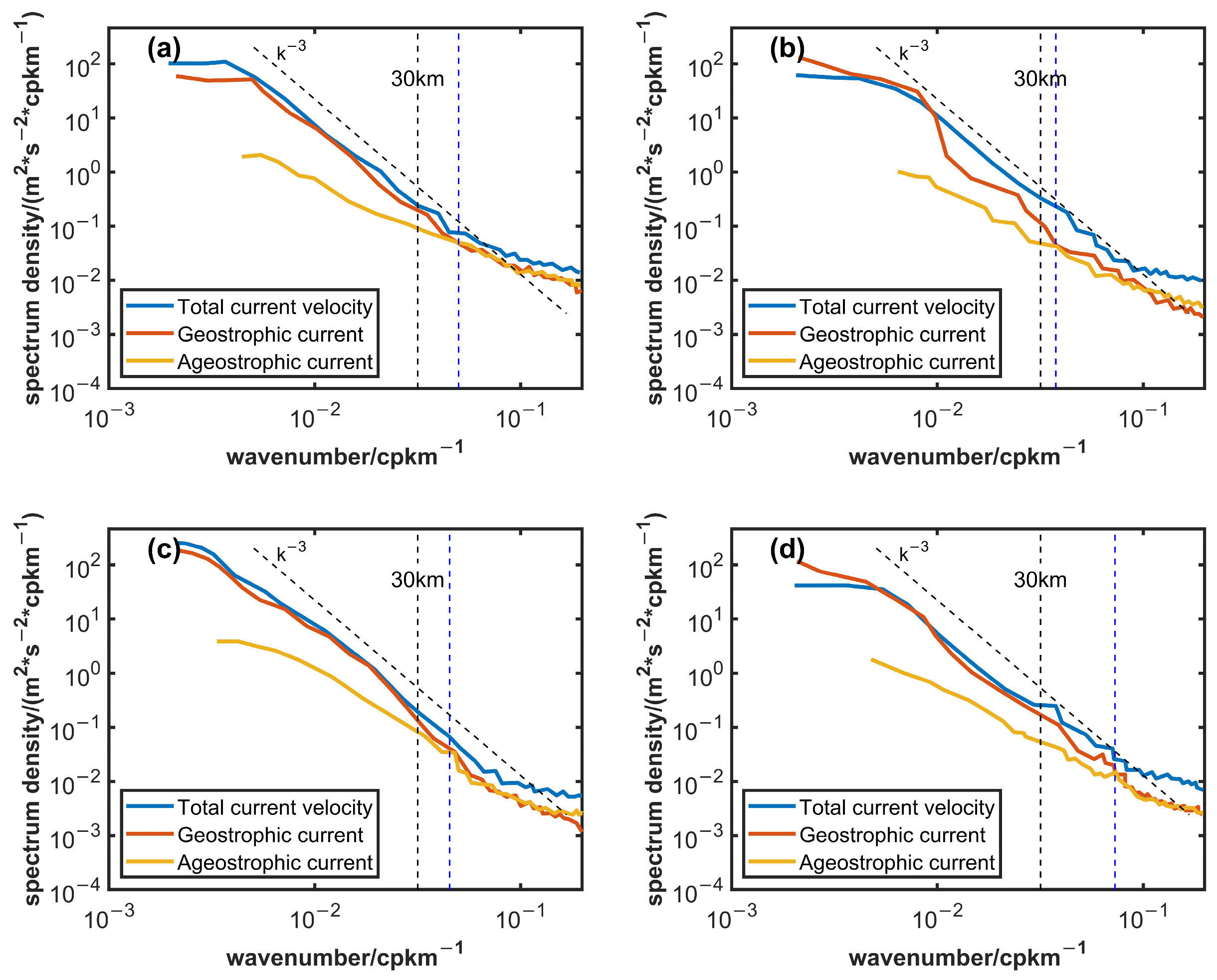


Disclaimer/Publisher’s Note: The statements, opinions and data contained in all publications are solely those of the individual author(s) and contributor(s) and not of MDPI and/or the editor(s). MDPI and/or the editor(s) disclaim responsibility for any injury to people or property resulting from any ideas, methods, instructions or products referred to in the content. |
© 2024 by the authors. Licensee MDPI, Basel, Switzerland. This article is an open access article distributed under the terms and conditions of the Creative Commons Attribution (CC BY) license (https://creativecommons.org/licenses/by/4.0/).
Share and Cite
Peng, Z.; Zhang, S. Seasonal Variation of Submesoscale Ageostrophic Motion and Geostrophic Energy Cascade in the Kuroshio. J. Mar. Sci. Eng. 2024, 12, 1121. https://doi.org/10.3390/jmse12071121
Peng Z, Zhang S. Seasonal Variation of Submesoscale Ageostrophic Motion and Geostrophic Energy Cascade in the Kuroshio. Journal of Marine Science and Engineering. 2024; 12(7):1121. https://doi.org/10.3390/jmse12071121
Chicago/Turabian StylePeng, Zihao, and Shuwen Zhang. 2024. "Seasonal Variation of Submesoscale Ageostrophic Motion and Geostrophic Energy Cascade in the Kuroshio" Journal of Marine Science and Engineering 12, no. 7: 1121. https://doi.org/10.3390/jmse12071121
APA StylePeng, Z., & Zhang, S. (2024). Seasonal Variation of Submesoscale Ageostrophic Motion and Geostrophic Energy Cascade in the Kuroshio. Journal of Marine Science and Engineering, 12(7), 1121. https://doi.org/10.3390/jmse12071121



